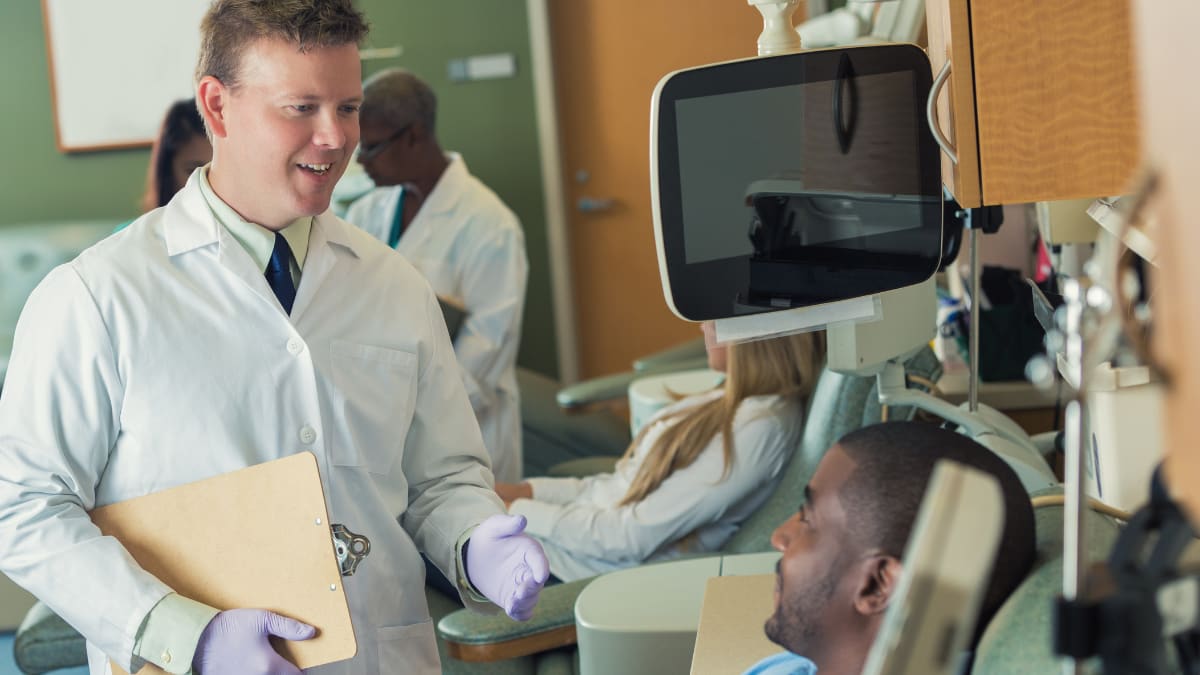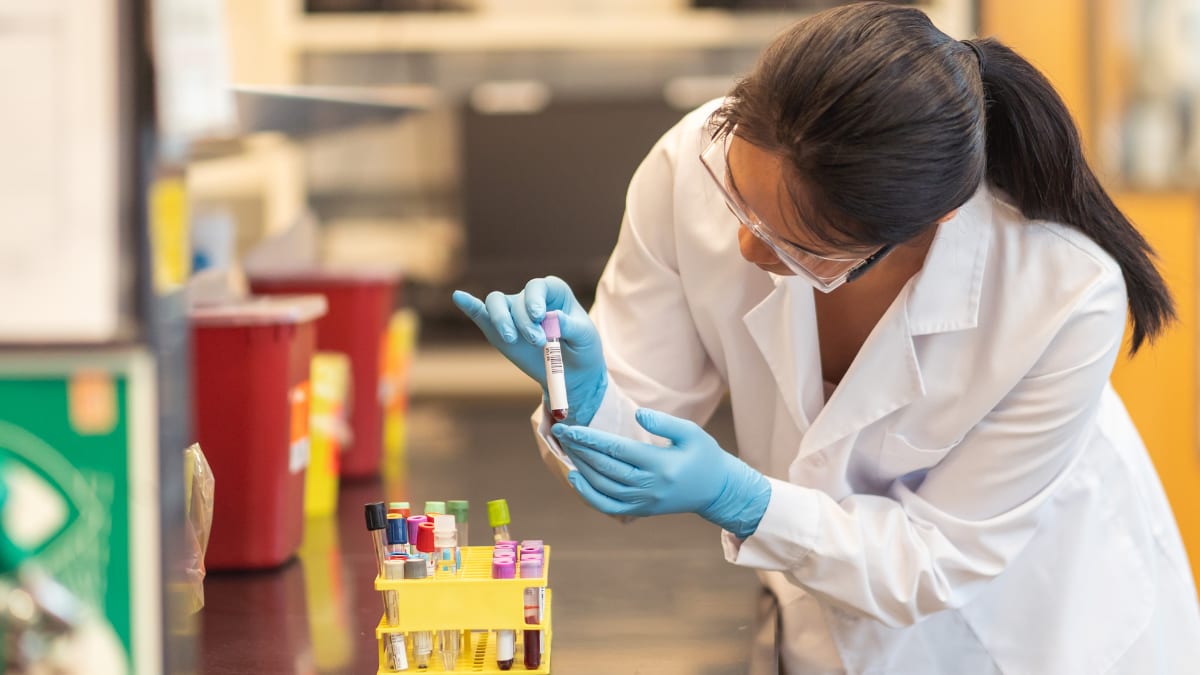How to Become a Phlebotomist: Top Degree Programs to Consider

Are you interested in becoming a phlebotomist? We have tips and resources to help guide you along this in-demand career path.
Key Takeaways
- Phlebotomists are health care professionals whose top responsibility is drawing blood samples from patients.
- It is possible to become a certified phlebotomist with as little as 1 to 2 years of education.
- Many community colleges, vocational schools, and technical institutes offer accredited phlebotomy certificate programs.
Phlebotomy is a good option for students seeking an accessible and affordable way to start a medical career. In most cases, it is possible to become a phlebotomist by earning a certificate from an accredited phlebotomy program. Moreover, earning an associate degree in a related subject such as biology, nursing, or human sciences may improve your earning potential and expand your job opportunities.
But first, let’s take a closer look at the career path for aspiring phlebotomists.
In short, there are four basic steps to becoming a phlebotomist:
- Step 1: Earn High School Diploma or GED
- Step 2: Complete Accredited Post-Secondary Non-Degree Certificate or Associate Degree Phlebotomy Program
- Step 3:Pass National Certification Exam and Become Licensed in Your State
- Step 4: Find a Job!
But what does this process look like? How long does it take? How much does it cost? And what are the most common pathways into the field?
Read on to find out...

An Overview of the Phlebotomy Profession
Phlebotomists serve in a critical support role in the medical field. Phlebotomists are primarily responsible for collecting blood draw samples from patients in a wide variety of healthcare settings. Phlebotomists may work in hospitals, clinics, charitable blood donation facilities, and more.
What do phlebotomists do?
As noted above, phlebotomists and phlebotomy technicians are primarily responsible for drawing blood from patients and preparing these blood specimens for testing. But there are a number of other important duties that phlebotomists will typically perform.
These duties may include:
- Explaining the procedures used to collect blood samples and putting patients at ease with the process.
- Checking vitals such as blood pressure, pulse, and temperature.
- Performing blood transfusions in certain medical facilities.
- Sending urine, fecal, and blood samples to the lab for testing.
- Maintaining, using, and sanitizing equipment.
- Handling private medical, diagnostic, and health insurance information.
- Properly disposing of used needles and other testing materials.
- Maintaining a safe, sanitary, and private treatment setting.
These are all essential responsibilities in the patient care process. But in a lot of ways, the role of the phlebotomist goes beyond these important duties.
Some patients experience anxiety or even fear over blood drawing. Most patients experience at least mild discomfort. As a phlebotomist, one of your most important responsibilities is showing compassion, providing comfort, and serving as a calming presence.
Bottom Line: While your basic job description is to draw and handle blood samples, your real role as a phlebotomist combines the technical aspects of diagnostic testing and a human-centered approach to patient care. Simply stated, “bedside manner” is critically important in this line of work.

Back to Top
Phlebotomy Technicians vs. Phlebotomists: What’s the difference?
There are no fundamental differences between a phlebotomist and phlebotomy technician. In most cases, these may be considered interchangeable names for the same position.
Your actual job title may vary depending on your employer. However, whether you are referred to as a phlebotomist or a phlebotomy technician, your responsibilities are essentially the same as those described in the section above.
In some instances, a registered phlebotomy technician may have more specific “lab tech” responsibilities such as maintaining, operating, and sterilizing medical equipment. But these distinctions have less to do with job title than with the specific job description from a given employer.
Understanding Certification: What’s the difference between a phlebotomy certificate and certification?
Before reading on, it’s important to understand the difference between earning a phlebotomy certificate and a phlebotomy certification. Though these terms sound similar, they are actually quite different:
- A Phlebotomy Certificate is the credential you’ll earn at the end of an accredited, post-secondary phlebotomy training program. Certificate-based phlebotomy programs are typically offered by community colleges, vocational schools or technical institutes. An accredited certificate program can usually be completed in a year or less, and will qualify you to sit for the National Certification Exam.
- Phlebotomy Certification is a national professional certification. You must pass the National Certification Exam to earn this certification. Certification will be granted by the state licensing agency in your state.
Qualifying for Phlebotomy Certification
As noted above, there are several different pathways to certification, but the rules may differ from one state to the next. Make sure you know the requirements in your state before choosing your path to certification. These factors will impact both the length and cost of your education.
How long does it take to become a phlebotomist?
The length of time from high school graduation to employment can vary depending on the path you choose to take. However, you can generally expect to complete your phlebotomy education and certification over a period of 1 to 2 years.
In most states, you have three pathways to becoming a certified phlebotomist:
- Earn a high school diploma or GED, and gain at least one year of experience in the field.
- Earn an accredited non-degree certificate in phlebotomy from a post-secondary institution like a community college, vocational school, or technical school. Depending on pacing, this can take anywhere from four weeks to a year.
- Earn an accredited associate degree in a related subject like health science, biology, or nursing. Most associate degree programs can be completed in two years, though there may be accelerated options that can be completed in as little as one year.
When is an associate degree the right choice to becoming a phlebotomist?
An associate degree program may be preferable if you’re seeking a well-rounded educational experience in addition to practical training in phlebotomy. Most associate degrees require 60 credit hours, many of which can be completed online.
While an associate degree will take more time and cost more than a certificate program, there are a few good arguments in favor of this option:
- Earning an associate degree may help you stand out in a competitive marketplace.
- An associate degree gives you a chance to add valuable skills in areas like communication, organizational leadership, psychology, and more. These skills may help you advance to specialized roles in phlebotomy.
- Some clinical healthcare settings may require you to have a minimum of a two-year degree. An associate degree may expand your employment opportunities.
- You’ll have a head-start if you decide to complete a four-year degree program and pursue a role such as registered nurse.
If you decide to pursue an associate degree, look for a program with a concentration in phlebotomy. If your associate degree does not include a phlebotomy concentration, you will likely be required to complete a certification training program—which typically takes 4 to 6 weeks—before taking your certification exam.
Bottom Line: An associate degree may cost more than a certificate program, at an average of just over $10,000 per year over two years. However, this is a much more affordable option than many other healthcare careers that require a four-year degree, such as registered nursing. The average annual tuition for a four-year degree is higher than $19,000.
Other Factors to Consider on Your Path to Becoming a Phlebotomist
Before you choose the right path for you, there are a few factors to consider:
- You may be able to become a phlebotomy technician by completing a 4 to 8 week training program. However, not all accelerated vocational programs qualify you for certification. If you plan to become certified in your state—and we strongly recommend that you do—make sure your certificate program is accredited.
- Certification is optional in most states. However, most employers will be seeking candidates with some level of national certification.
- Completing an accredited associate-level degree program can be a great way to combine a phlebotomy concentration with other valuable education like counseling, research or communication skills. Each of these skills can help qualify you for higher paying specializations in areas such as family services or research and development. Phlebotomists in both of these areas make an average annual salary of $44,000+.
The Bureau of Labor Statistics identifies the National Accrediting Agency for Clinical Laboratory Sciences (NAACLS) and the American Society for Clinical Pathology (ASCP) as two leading accrediting agencies for phlebotomy certificate programs.
According to the National Healthcareer Association (NHA), an agency which administers the Certified Phlebotomy Technician (CPT) examination, 93% of employers prefer certified phlebotomy technicians. In other words, we strongly recommend pursuing an educational path that leads to certification. This will significantly improve your employment outlook.
The Certification Exam to Become a Phlebotomist
You will need to sit for a certification examination. Many vocational degree programs include a certification exam prep component. If your associate degree does not include this component, it may be advisable to spend 4 to 6 weeks preparing.
There are numerous verified agencies that are authorized to administer the certfication exam including:
- American Certification Agency (ACA)
- American Medical Technologists (AMT)
- National Center for Competency Testing
- National Healthcareer Association
- National Phlebotomy Certification Examination
Mometrix notes that the overall pass rate for the national certification exam is just over 75%. Be sure you utilize the study guides, practice tests, and other resources available to you in preparation.
Bottom Line: The length of time it takes you to become a certified phlebotomist will depend on your career goals. While it is possible to become a phlebotomist in less than a year, your career goals and state-based requirements may require specific credentials.
Make sure you know which credentials you’ll need before choosing your educational path. And consider the associate degree a great way to add other valuable employment skills to your practical phlebotomy training.
How much does it cost to become a certified phlebotomist?
As noted above, you have several options for becoming a certified phlebotomist. The cost of your education will depend on the path you choose:
- High School Diploma/GED: Your education will be free but you will need to gain a year of professional experience to qualify for certification.
- Phlebotomy Certificate: The cost of your certificate may vary from $1500 to $2500. Be sure your certificate program is properly accredited by a recognized agency such as the National Accrediting Agency for Clinical Laboratory Sciences (NAACLS) and the American Society for Clinical Pathology (ASCP).
- Associate Degree: The average accredited associate degree costs about $10,000 per year. However, there are plenty of affordable associate degrees that cost less than $10,000 a year.
Whichever of these paths you choose, you will be required to pass the National Certification Exam in order to become certified in your state. The cost of your exam will vary from state to state, but will generally cost about $50 to $150.
Bottom Line: No matter which path you take, the education required to become a phlebotomist is relatively affordable compared to the education required for many other patient care roles. For instance, lab technicians and registered nurses must typically earn a bachelor’s degree, which costs an average of $19,000 per year over a minimum of four years. Even the costliest path of entry for phlebotomists—the associate degree—will take half the time and a quarter of the cost.
What levels of certification are there?
The most basic level of certification is Limited Phlebotomy Technician (LPT). This licenses you to draw blood using a basic skin puncture technique. Additional testing may be required for higher levels of certification such as Certified Phlebotomy Technician I (CPT I) and Certified Phlebotomy Technician I (CPT II).
CPT I and CPT II certification license phlebotomists to perform a wider range of blood drawing techniques.
Is certification required?
Certification may not always be required by your state, but it is highly recommended.
Indeed, certification is technically optional in many states. However, many prospective employers will expect or even require certification. As noted above, surveys show that the vast majority of employers prefer to hire certified phlebotomy technicians.
Bottom Line: In other words, you are strongly advised to pursue certification regardless of where you live. As noted directly above, the cost of certification testing is relatively low ($50-$150). For this modest cost, you will receive a credential that will significantly improve your employment prospects, opportunities for advancement, and earning potential.
Learn more about how to pursue the best-paying career opportunities for phlebotomists.
Back to TopThe Best Degrees for Phlebotomists and Phlebotomy Technicians
As noted above, there are several different pathways to qualifying for certification. However, the most popular and affordable way is to earn an occupational certificate in phlebotomy. Numerous two-year schools offer excellent phlebotomy certificate programs that incorporate both classroom instruction and clinical training.
Read on for a look at some of the community colleges, vocational schools, and technical institutes noted for their phlebotomy certificate programs.
Tuition + fees
$2K
Graduation
49%
Student body
7K
Career Outlook for degree at Eastern Arizona College
Cost of Degree: $2,232Expenses: $12,686Starting Salary: $35,700Cost Recoup Time: 9 yearsPaid back at 15% of annual salaryWhat is Eastern Arizona College known for?
Eastern Arizona College’s faculty and alumni have been influential in:
Most Influential Alumni
Eastern Arizona College offers a two semester phlebotomy technician program. Completing this program qualifies you to sit for the American Medical Technologists (AMT) certification Examination.
- #4 50 Best Community Colleges Ranked for Students in 2024 #4 Best Community Colleges in California 2024
Tuition + fees
$2K
Graduation
67%
Student body
27K
Career Outlook for degree at De Anza College
Cost of Degree: $1,562Starting Salary: $50,200What is De Anza College known for?
De Anza College’s faculty and alumni have been influential in:
- Psychology
- Computer Science
- Business
- Mathematics
- Communications
- Criminal Justice
- History
- Sociology
- Economics
- Law
Most Influential Alumni
De Anza College’s Health Technologies Department offers a Certificate of Achievement for completion of the Phlebotomy Technician I program, which trains students in the clinical skills of performing venipunctures, setting up lab tests, and processing specimens for testing in clinical labs. The certificate program is recognized by the California Department of Public Health- Laboratory Field Services.
Tuition + fees
$7K
Graduation
37%
Student body
13K
Career Outlook for degree at Elgin Community College
Cost of Degree: $7,140Starting Salary: $35,800What is Elgin Community College known for?
Elgin Community College’s faculty and alumni have been influential in:
Elgin Community College offers a two-semester vocational training program that combines classroom education with on-site clinical lab training. Completion of the program qualifies students to sit for the phlebotomy technician certification exam offered by the American Society of Clinical Pathology (ASCP).
Tuition + fees
$10K
Graduation
34%
Student body
20K
Career Outlook for degree at College of Lake County
Cost of Degree: $9,842Starting Salary: $37,200What is College of Lake County known for?
College of Lake County’s faculty and alumni have been influential in:
College of Lake County offers a Career Certificate program that consists of 96 credit hours—a combination of theory studies and clinical laboratory practice. Students must also complete a 3-week real-world practicum under the supervision of phlebotomy or medical tech professionals. Students completing the program, which includes a fast-track 11-week option, are eligible to sit for national certification.
Tuition + fees
$1K
Graduation
44%
Student body
14K
Career Outlook for degree at Cuesta College
Cost of Degree: $1,340Starting Salary: $42,100What is Cuesta College known for?
Cuesta College’s faculty and alumni have been influential in:
- Physics
- Computer Science
- Social Work
- Law
- Criminal Justice
- Mathematics
- Business
- Biology
- Earth Sciences
- Political Science
Most Influential Alumni
Cuesta College offers a 1-semester, 18-week certificate program which is divided into classroom-based instruction and a real world clinical externship. Cuesta’s program is included in the California Department of Public Health’s list of Approved Phlebotomy Training Schools.
Tuition + fees
$3K
Graduation
64%
Student body
4K
Career Outlook for degree at Florida Gateway College
Cost of Degree: $3,100Expenses: $8,667Starting Salary: $32,500Cost Recoup Time: 8 yearsPaid back at 15% of annual salaryWhat is Florida Gateway College known for?
Florida Gateway College’s faculty and alumni have been influential in:
Florida Gateway College offers a 165-hour Occupational Certificate program combining classroom instruction and clinical practice over the course of single semester.
Bottom Line: The community colleges and vocational schools above generally require in-person instruction because the hands-on, clinical training is a critical part of your phlebotomy education. This means that the best way to find the best phlebotomy program for you is to check out course and certificate offerings at the best community colleges in your state.
Phlebotomy Career Information
Once you are certified, you are qualified to seek work as a phlebotomist in your state. Phlebotomists work in a variety of settings, including hospitals, clinics, and blood donation centers. But before you decide exactly where you want to work, there’s actually quite a bit to consider.
The section below offers a deeper dive into the job opportunities and salary range that await you after earning your phlebotomy certification.
What is the job outlook for phlebotomists?
The job outlook for phlebotomists is very good. Phlebotomists enjoy both a stronger than average rate of growth compared to all jobs, and a high median salary compared to other medical support roles.
Job Growth for Phlebotomists
The Bureau of Labor Statistics says that job openings for phlebotomists will grow roughly 10% between 2021 to 2031. This is twice the 5% rate of growth for all occupations combined.
Phlebotomists are part of a broader growth trend in the healthcare sector. The Bureau of Labor Statistics projects that the United States economy will add nearly 2 million jobs over the next decade. The demand for phlebotomists is likely to grow over that time.
There are a number of reasons for this strong growth outlook including:
- The rate of aging and retirement among current phlebotomists;
- A growing demand for diagnostic testing in a wide range of healthcare settings; and
- Higher life expectancy, an aging U.S. population, and, consequently, a growing set of medical needs.
Indeed, phlebotomists work in an extremely wide range of settings such as diagnostic laboratories, public health agencies, outpatient care centers, blood banks, and more. This means employment opportunities abound throughout the expanding healthcare labor market.
Salary Range for Phlebotomists
According to the Bureau of Labor Statistics, phlebotomists in the United States earned a median salary of $37,380 per year in 2021. This is higher than the average pay for all medical support personnel, which was $28,990 in 2021.
In fact, in 2021:
- Only the lowest 10% of earners among phlebotomists earned an average salary of $28,990 or less.
- The highest 10% earned an average salary of $48,490, which was higher than the median pay for all workers of $45,760.
In other words, phlebotomists earn a higher than average salary as compared to other medical professionals with equivalent education and certification. However, there are several factors that can play a major role in your earning power, including:
- Industry
- Certification
- Specialization
- Experience
- Geography
Each of these factors can have a big impact on how much you are likely to earn as a phlebotomist. But it’s important to look at the big picture. As noted, phlebotomists can work in a wide variety of healthcare, diagnostic and research settings.
Salary Factors: A Closer Look
But the salary range can vary according to setting. 36% of all phlebotomists work in hospitals, where the average pay was $37,430 in 2021. Another 35% work in testing and diagnostic centers, where the median pay was $40,570. And at the highest end of the pay range, phlebotomists who worked for charitable organizations earned an average salary of $57,210.
So what does that mean for you? When you pursue your education and certification, make sure you know what top-paying employers are looking for. While you can earn a phlebotomy certificate in a year or less, earning an associate degree in Nursing, Health Science or Biology may qualify you for some higher-paying positions in the field.
And of course, bear in mind that factors like geography can also play a major role in what you’ll earn. Phlebotomists in states like California ($48,070) and New York ($45,390) earn the highest median salary. But the cost of living is also comparatively high in these states. The same is true for phlebotomists living in major metropolitan areas–both the pay and cost of living are on the higher end of the spectrum.
Bottom Line: How much you earn as a phlebotomist will depend on the full combination of factors above. While phlebotomists do earn a higher-than-average salary among medical support personnel with a similar level of education and training, it’s up to you to determine the right combination of industry, credentials, and geography.
For instance, if you plan to work and live in a costlier state, you may benefit from earning more advanced credentials and certifications. (See below for more on these credentials and certifications.)
Check out our even deeper dive into phlebotomy careers and salaries.

Ongoing Education for Phlebotomists
Phlebotomists who are already working in the field may also pursue continuing education courses and ongoing certification. Here, you’ll have an opportunity to take continuing education phlebotomy programs and remain up to date on best practices, new equipment, and more. This can also be a great way to enhance your skills and potentially qualify for other healthcare industry career opportunities.
You have a lot of options for continuing phlebotomy training through leading professional associations like American Medical Technologists, Phlebotomy Training Specialists, and more. It may be possible to add to your qualifications with training in specialized equipment, organizational management skills, or additional medical training. Each of these added skills could improve your earning potential.
For more helpful advice on taking the next step in your career, check out our Career Guidance homepage.
Or get valuable study tips, advice on adjusting to campus life, and much more at our student resource homepage.